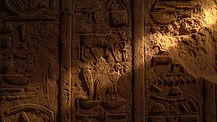

Music Academy

How is Music Created?
First, when an object is struck, vibrations are produced.
Sound
The vibrations generated lead to the creation of sound. Sound is the fundamental element of music.
Naad (Resonant Sound)
In music, sound is referred to as Naad. The word "Naad" is generally believed to originate from the root word 'Nad', which means an unmanifested sound. The manifested forms of this unmanifested sound are letters, words, sentences, and musical notes.
नदोपासनाया देवा ब्रह्मविष्णुमहेश्वराः ।
भावन्तुपसिता नूनं यासमादेते तदात्मकोंः ॥
नकारं प्रांणमामानं दकारमनलं बिंदु:।
जात: प्राणअग्नि संयोगातेनम नदोभिधीयते ।।
This means that in the word Naad, "Na" symbolizes the life force (prana-vayu), and "Da" represents fire (agni). Since Naad is created from the combination of prana (breath) and agni (fire), its name is meaningful and justified.

For Hindi


Types of Naad (Sound)
Naad is primarily classified into two types:
1) Aahat Naad
-
Sound, words, and voice are all forms of Aahat Naad.
-
It is produced by striking an object, friction, or the collision of two physical objects.
-
This sound can be heard by the ears and serves as the foundation of music.
2) Anahat Naad
-
Anahat Naad is generated without any external impact.
-
It can only be heard and understood by yogis, who attain liberation through it.
-
This sound is experienced in a state of perfect harmony between the mind and intellect.
-
By immersing themselves in this Naad, yogis experience divine bliss (Brahmananda).
Shruti (Microtones)
-
Shruti is the smallest audible unit of sound or Naad.
-
According to Sangeet Ratnakar, "श्रवणच्छुतयो मता:"—which means that Shruti is so named because it can be heard.
-
Shruti refers to the subtle sounds that can be perceived and used in music to determine the intervals between musical notes.
-
According to Bharat Muni and other scholars, there are 22 Shrutis in Indian classical music.
-
In ancient and medieval times, scholars placed musical notes on the last Shruti of their respective positions.
-
However, modern scholars place notes on the first Shruti of their respective positions.
-
The arrangement of these Shrutis follows a 4-3-2-4-4-3-2 pattern.
This classification forms the basis of the tonal structure in Indian classical music.


Shruti Name According to
Ancient Scholars
1. Teevra
2. Kumudvati
3. Manda
4. Chandovati
5. Dayavati
6. Ranjani
7. Raktika
8. Raudri
9. Krodha
10. Vajrika
11. Prasarini
12. Preeti
13. Marjani
14. Kshiti
15. Rakta
16. Sandeepani
17. Alapini
18. Madanti
19. Rohini
20. Ramya
21. Ugra
22. Kshaubhini
Shadaj
Rishabh
Gandhar
Madhyam
Pancham
Dhaivat
Nishad
According to
Modern Scolars
Shadaj
Rishabh
Gandhar
Madhyam
Pancham
Dhaivat
Nishad


Swara (Musical Notes)
In the context of sound, the concept of Swara has been considered in the Vedas, grammar, and various philosophical traditions in three primary ways:
-
In language – As vowels like अ, इ, उ etc.
-
In Vedic literature – As tonal variations such as Udātta (raised), Anudātta (lowered), and Svarita (middle tone).
-
In Sāmaveda singing – As the seven musical notes (Saptaswaras).
रंजयतिजयति स्वतः स्वान्तम् श्रोत्रुणामिति ते स्वराः ।
षडजर्षभौ च गांधारत्था मध्यमपंचमौ ॥
धैवतश्त निषादोयमिति नामभिरीरिताः ।
This means that the sounds which naturally and spontaneously attract the minds of listeners are called Swara. The seven Swaras are Shadja (Sa), Rishabh (Re), Gandhar (Ga), Madhyam (Ma), Pancham (Pa), Dhaivat (Dha), and Nishad (Ni), which are referred to by these names.
There are a total of 7 Shuddha (natural) Swaras, 4 Komal (flat) Swaras, and 1 Teevra (sharp) Swara, making a total of 12 Swaras, which are arranged as follows:
|
S R R G G M M P D D N N
1 2 3 4 5 6 7 8 9 10 11 12
Thaat
A specific arrangement of Swaras that serves as the foundation for the creation of Ragas and Raginis is called Thaat (also spelled Thaat/Thaṭh). In South Indian music, this system is referred to as ‘Mel’. Some ancient texts also use the term ‘Sansthan’ to describe this concept.


Thaat
-
Bilawal Thaat – All notes are natural (Shuddha).
S R G M P D N -
Kalyan Thaat – Only Ma (Madhyam) is sharp (Tivra), all other notes are natural (Shuddha). . | S R G M P D N
-
Khamaj Thaat – Ni (Nishad) is flat (Komal), all other notes are natural (Shuddha).
S R G M P D N -
Kafi Thaat – Ga (Gandhar) and Ni (Nishad) are flat (Komal), all other notes are natural (Shuddha).
S R G M P D N -
Asavari Thaat – Ga (Gandhar), Dha (Dhaivat), and Ni (Nishad) are flat (Komal), all other notes are natural (Shuddha).
S R G M P D N
6.Bhairav Thaat – Re (Rishabh) and Dha (Dhaivat) are flat (Komal), all other notes are natural (Shuddha). S R G M P D N
7.Marwa Thaat – Re (Rishabh) is flat (Komal), Ma (Madhyam) is sharp (Tivra), all other notes are natural (Shuddha).
|
S R G M P D N
8.Poorvi Thaat – Re (Rishabh) and Dha (Dhaivat) are flat (Komal), Ma (Madhyam) is sharp (Tivra), all other notes are natural (Shuddha).
|
S R G M P D N
9.Todi Thaat – Re (Rishabh), Ga (Gandhar), and Dha (Dhaivat) are flat (Komal), Ma (Madhyam) is sharp (Tivra), all other notes are natural (Shuddha).
|
S R G M P D N
10.Bhairavi Thaat – Re (Rishabh), Ga (Gandhar), Dha (Dhaivat), and Ni (Nishad) are flat (Komal), all other notes are natural (Shuddha).S R G M P D N
There is still a lot more to understand, learn and know
beyond this but it will become more clear if you learn it with the Guru.